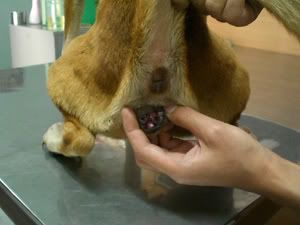I have came across this topic in class few days ago.
****************************************************

A dog suffering from TVT
Introduction and etiology
Canine transmissible venereal tumor (CTVT), also called transmissible venereal tumor (TVT), Canine transmissible venereal sarcoma (CTVS), Sticker tumor and infectious sarcoma is a histiocytic tumor of the dog and other canids that mainly affects the external genitalia, and is transmitted from animal to animal during copulation or social behavior such as sniffing and licking. It is one of only three known transmissible cancers; another is Devil facial tumor disease, a cancer which occurs in Tasmanian devils. Females are slightly more prone to tumor development than males. It occurs more commonly in young dogs. TVT may also can be transmitted from the infected bitch to puppies
Sniffing (or licking) of healthy intact dog may predispose the transmission of the TVT fromthe infected dog during sexual or social behaviour
TVT are cauliflower-like, pedunculated, and nodular, papillary, or multilobulated in appearance. They range in size from a small nodule (5 mm) to a large mass (>10 cm) that is firm, though friable. The surface is often ulcerated and inflamed and bleeds easily. TVT may be solitary or multiple and are almost always located on the genitalia. They may be transplanted to adjacent skin and oral, nasal, or conjunctival mucosae. The tumor may arise deep within the prepuce or vagina and be difficult to see during cursory examination. This may lead to misdiagnosis if genital bleeding is incorrectly assumed to be hematuria. The tumor is transplanted from site to site and dog to dog by direct contact with the mass. Initially, TVT grow rapidly. Metastasis is uncommon (5%). When metastasis occurs, it is usually to the regional lymph nodes, but kidney, spleen, eye, brain, pituitary, skin and subcutis, mesenteric lymph nodes, and peritoneum may also be sites.
Lesions of TVT on the penis of an infected dog
Up until this moment, there is no exact etiology of how the tumor can be transmitted to the dog. It was believed that the virus is the media that transmits the tumor genes, but there is no clear cut explanation of how this can occur.
Signs and symptom
The infected dogs/pups may experience
- A visible mass on the penis or vagina (note the external genitalia)
- Blood dripping from the penis or vagina
- Frequent licking of the genetalia
- Similar masses in the mouth or nose (tumors can spread to these sites from direct contact)
Spreading of TVT to the head
Diagnosis
History and physical exam. It is important to know the animal's sexual history. Physical exam should reveal a reddened, possibly bleeding, lobulated tumor. This may not be apparent without careful examination, as it may be covered by the sheath of the penis or the vulva.
Fine needle aspirate. Aspiration of cells from the mass using a needle and syringe usually yields a diagnosis. The cells are examined microscopically to characterize the tumor type.
Fine-needle aspiration reveals a moderately cellular sample of discrete round cells. Anisocytosis (irregular size of cell) and anisokaryosis (irregular size of nucleoli) may be present but usually are not prominent. A few cells may be binucleate. Individual cells usually have a round to reniform nucleus with inapparent nucleoli. Folds or clefts in the nuclear membrane sometimes produce a unique appearance called a "butt cell" (wherein the nucleus resembles buttocks). The cytoplasm is typically light blue and lacks both vacuoles and granules. Mitotic figures are common. Inflammatory cells, especially lymphocytes and plasma cells, are often dispersed among the tumor cells, especially during regression of the neoplasm.

Histiocytoma, Wright-Leishman stain. Neoplastic cells have a round to oval nucleus and light blue cytoplasm that lacks vacuoles and granules. A mitosis (bottom center) and "butt cell" (upper left) also are present.
Complete blood count and biochemical profile. These are routine blood tests that should be performed prior to medical treatment of the tumor. They should be normal in animals with TVT.
Treatment
Chemotherapy is very effective for TVT, but surgery alone often leads to recurrence. Surgery may be difficult due to the location of these tumors. The prognosis for complete remission with chemotherapy is excellent.The most common chemotherapy agents used for TVT are vincristine, vinblastine, and doxorubicin.Radiation therapy may be effective when chemotherapy does not work.

Before treatment

Effect of treatment after 1 month
Home care and Prevention
Monitor for response to therapy and prevent self-trauma by putting an Elizabethan collar on per dogs. Spay or neuter the dogs and do not allow exposure to unknown dogs.
Sources: TVT, Wikipedia.org, TVT, petplace.com, Merck's veterianary manual, Canine round cell tumor, Vet.clinical pathology clerckship program




















1 comments:
The pictures that supposedly shows spreading of TVT to the head, is in reality a picture of a TASMANIAN DEVIL affected by Tasmanian Devil Facial Tumour Disease (DFTD)! That is not even a dog!!!
Post a Comment